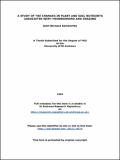A study of the changes in plant and soil nutrients associated with moorburning and grazing
Abstract
From the Summary: "The work has consisted of the measurement of processes
connected with the normal management of grouse moors in the
Glen Clova area of Angus.
The problems associated with burning have been summarised
together with the remits of previous work.
The geology and topography of Glen Clova have been
described briefly, and the vegetation of the Rottal area of
the glen has been described in detail with respect to the
particular parts under consideration.
A method of ring counts has been used to define the age
of Calluna stands.
The methods used for analysis of mineral nutrients have
been described. One method, Atomic Absorption Spectroscopy,
has required extensive calibration and has been described in
more detail.
It has been shown that the temperature and duration of
heath fires depends upon the age of the vegetation.
The temperature and duration of a fire determined the
loss of nitrogen in the form of smoke.
The temperature of a fire has been shown to affect the
solubility of nutrients in ash. Increase in temperature
caused a greater release of soluble potassium and calcium,
but a decrease in soluble phosphate, The release of mineral
nutrients from Calluna leaf litter has been compared with
that from ash.
Experiments were instigated to measure the effect of
grazing upon the yield and mineral content of Calluna, the
greatest effect being found 5 - 10 years after burning.
The addition of mixed fertiliser to some of the stands
was found to increase the yield and nutrient content of the
leaven of Calluna.
Soil samples from 22 stands of Calluna were analysed in
November each year, for three years, and the total content
of nitrogen, phosphate, potassium, magnesium, calcium and
iron estimated. In the first instance other analyses
including pH, conductivity, organic carbon and mechanical
analysis were performed in order to distinguish between the
two soil types present. Significant changes in the nutrient content of the soils have been discussed.
A balance sheet of the losses and gains to the ecosystem
was prepared to indicate the changes in mineral nutrients.
it has been calculated that the potential losses of individual nutrients by leaching, ignition and grazing could be
replaced over a period of 15 years from rainwater, with
the exception of phosphate which is only present in small
quantities in rainwater.
The implications of the results have been discussed."
Type
Thesis, PhD Doctor of Philosophy
Collections
Items in the St Andrews Research Repository are protected by copyright, with all rights reserved, unless otherwise indicated.

